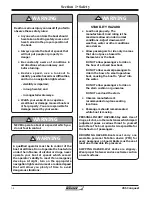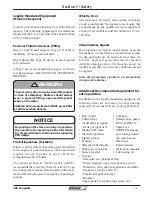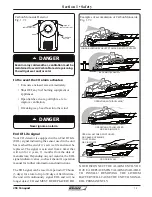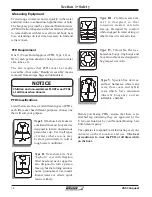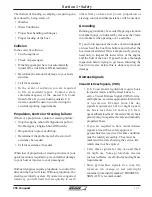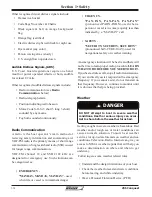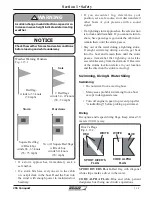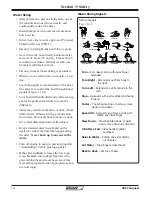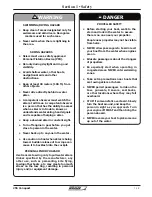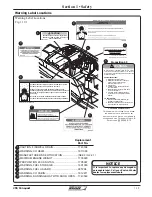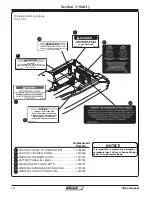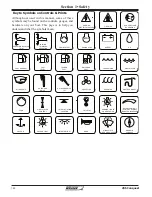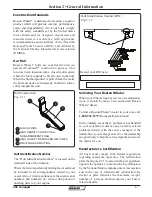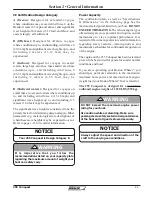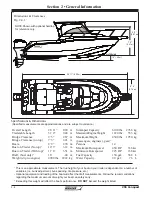
1-11
Section 1 • Safety
255 Conquest
R
others that you have lost power, propulsion or
steering control and that assistance will be needed.
Grounding
Running aground may be avoided by paying attention
to marker bouys or indicated by waves as they form
into breakers when passing over a sand bar.
If you do run aground, the course of action depends
on how hard the boat hits bottom and whether the
boat remains stranded. If it is a simple touch, you may
need only to inspect the lower drive of the engine
and the hull of the boat. If posssible do a thorough
inspection before trying to get loose, throwing the
boat into reverse before this is done may do more
damage.
Distress Signals
Visual Distress Signals, (VDS)
• U.S. Coast Guard regulations require boats
in coastal waters and the Great Lakes to
carry a Visual Distress Signal (VDS) for day
and night use, as well as appropriate for the time
o f o p e r a t i o n . E x e m p t f r o m t h e d a y
signals requirement, but not night signals,
` are boats less than 4.8 meters (16 feet),
open sailboats less than 7.9 meters (26 feet), boats
participating in organized events and manually
propelled boats.
• If you are required to have visual distress
signals, at least three safety approved
pyrotechnic devices in serviceable condition
must be readily accessible. They must be
marked with a date showing the service life
which must not be expired.
• Carry three signals for day use and threE
for night use. Some pyrotechnic devices
such as red fl ares, meet both day and night use
requirements.
• Store pyrotechnic signals in a cool, dry
location. An orange or red watertight
container prominently marked “DISTRESS
SIGNALS” is recommended.
The chances of fl ooding, swamping or capsizing can
be reduced by being aware of:
• Weather
• Water Conditions
• Proper boat handling techniques
• Proper loading of the boat
Collision
In the event of collision:
• Cut the engine(s)
• Check on passengers
• If the bilge pump(s) have not automatically
turned ON, switch them ON immediately.
• Determine the amount of damage to your boats
structure.
• Call for assistance
• In the event of collision you are required
to file an accident report. Contact a state
enforcement agency or the nearest U.S. Coast
Guard offi ce. If you are boating outside U.S.
waters, consult the nation you are visiting for
accident reporting requirements.
Propulsion, Control or Steering failure:
If there is a propulsion, control or steering failure:
• Stop the engine, (shut off at Ignition or pull on
the Emergency Engine Shut-Off Switch.)
• Drop anchor to prevent drifting.
• Determine if the problem can be fi xed or will
assistance be needed.
• Call for assistance if needed.
When loss of propulsion or steering is noticed, your
quick reaction is required to prevent further damage
to your boat or injuries to your passengers.
Outboard engines require propulsion to control the
direction the boat will take. Without propulsion, the
steering is virtually useless. If you are in a congested
waterway you will need to react quickly to warn
Summary of Contents for 255 Conquest
Page 2: ......
Page 18: ...xviii 255 Conquest R THISPAGE INTENTIONALLY LEFT BLANK ...
Page 90: ...4 6 255 Conquest Section 4 Electrical System R Switch Panel Diagram Fig 4 6 1 ...
Page 91: ...4 7 Section 4 Electrical System 255 Conquest R DC Wiring Diagram Fig 4 7 1 ...
Page 94: ...4 10 255 Conquest Section 4 Electrical System R THIS PAGE INTENTIONALLY LEFT BLANK ...
Page 106: ...5 12 Section 5 Care Maintenance R 255 Conquest THIS PAGE LEFT INTENTIONALLY BLANK ...








